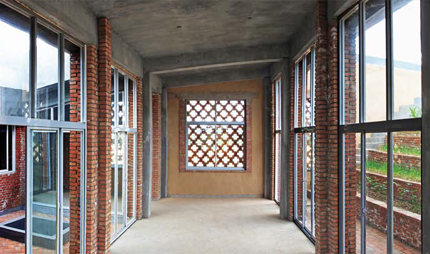THE FARMER’S HOME: A HOUSE FOR ALL SEASONS
| November 11, 2012 | Post In LEAP 17

This farmhouse is similar in size to those around it. Its foundation rests on a space of about 10 by 30 meters and sits squarely in front of a field. The outer surface is neatly lined with red bricks, interrupted by evenly spaced openings in the shape of small crosses, standing out among the other houses in the village and their one-door, two-window, whitewashed walls. Upon entering the house, it is immediately obvious how surprisingly intricate the interior is. The front yard has space enough to grow produce, while the backyard may be used to raise pigs and is equipped with an underground bio gas tank. In the space between, besides typical farmhouse necessities such as a greenhouse, bedrooms, a kitchen, a water collection basin, a bathroom, and a vegetable garden, there are also structures rarely seen in similar farm dwellings, including a formal living room and a terrace farm. The concrete terrace, which doubles as the roof, extends upwards in the shape of a staircase, to be used to dry grains or collect rainwater. The undulating slopes of the roof bring sunlight indoors, with solar panels installed near the bathroom. This farmhouse combines new design concepts with traditional northern elements, such as directing the heat generated by the stove directly to a chamber under the bed. Architecturally, the building combines a concrete column beam design with a heavy brick element, lining up the outer wall with clay bricks to at once ensure breathability and maintain privacy. The generous use of the most prosaic rural materials not only helps offset the cost of the complex structure, it also increases the structure’s ability to withstand earthquakes.

This farmhouse, named “House For All Seasons,” is designed by a team led by Assistant Professor John Lin of the University of Hong Kong. They began designing bridges, elementary schools, and dwellings for villages in Mainland China starting in 2006. The scales of their designs are usually not grand, but their treatments are always creative. They apply modern techniques and materials but stubbornly insist on supplementing these with local elements and traditions. In designing House for All Seasons, Professor Lin’s students studied many rural dwellings and realized that in recent years, the architectural style of this particular village had changed significantly. Most men who come of age travel to nearby cities, such as Xi’an, to find work, sabotaging the traditional family unit where all work is done within the family. Most building work is now done by hiring outside help instead. The new construction practice leads to unimaginative and repetitive designs, leaving spaces that are unfriendly to their inhabitants. At the same time, the traditionally self-sustainable rural living style is also no longer sustainable, leading to increasing reliance on the commercial and industrial output of nearby cities.
In light of this fact, we see that Lin’s design concepts buck the trend of the time, attempting to lead rural life back to its natural roots and slow down the rate at which cities are encroaching on rural areas. This structure may be seen as a prototype, which is based on the typical rural family unit: one family, one stove, one to two groups of beds; and fairly simplistic but providing all necessary water and power so that the family may be fully self-sustained, cultivating, harvesting, and breeding livestock without leaving the home. With proper respect to the sun and the four seasons, a family can live on its own without relying on urban and industrial production capacities.
This structure is a declaration against our age, confronting the irreversible footsteps of urbanization and industrialization, combining traditional agricultural wisdom with modern architectural technology to reproduce true self-sufficiency. From this perspective, its influence as an experimental prototype reaches far beyond rural areas. It paints a Utopian picture of complete freedom and independence for urbanites and ruralites alike.

